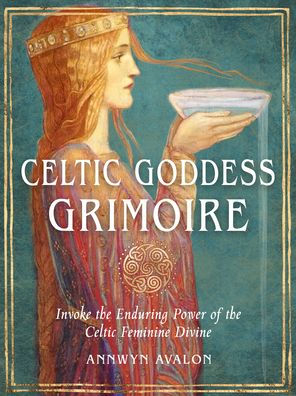I was both drawn to this book and had a bit of trepidation about reviewing it as I’m not at all conversant in Celtic spirituality, let alone its goddess traditions. I relaxed, though, within reading the first few pages. I was relieved, in a way, to read that author Annwyn Avalon—herself a long-time Celtic witch and founder of an Avalonian tradition called Triskele Rose— was daunted by this subject, vast and complex as it is.
Annwyn (I’ll call her here by her first name) is the author of two previous books about water witchcraft. In Celtic Goddess Grimoire, she writes of the pressure she felt, when asked to write this book, to produce “a perfect presentation of each goddess.” That wasn’t going to work, she writes, because there’s too little known about some of these beings. They don’t fit neatly into categories. There’s not even a single pantheon, as Celtic spirituality encompasses large territories throughout the British Isles and parts of continental Europe over many centuries. To organize a book by time or region wouldn’t have worked either because “these divine beings were not, in many cases, restricted by boundaries imposed by humans.” Annwyn’s process, then, was first to immerse herself in reading the scholarship of Celtic goddesses--- the mythology, archaeology, and folklore—and then to learn most about Celtic goddesses by “encountering them myself through life in ritual, and even by traversing the realms of the Otherworld through magic and shapeshifting.”
The result is what Annwyn calls an “introduction,” and I think she’s being too humble. This book is a compact grimoire packed with lore, chants, spells, and devotional practices. She begins with an overview of Celtic spirituality and its understanding of an Otherworld consisting of three realms: land, sky, and sea. Paradoxically, these are realms of the deceased and also full of life.
The Otherworldly realm of water, Annwyn writes, “holds special power and meaning in Celtic tradition because it connects with the ancestral realms and the realms of water spirits,” and because water is particularly associated with women and the mysteries of sacred sites. “Water was thought to be sacred across the Celtic world,” Anwynn writes, and this is known “from the survival of devotional offerings made to lakes, rivers, wells, and springs, as well as from the numerous shrines and ritual sites that have been found at locations associated with water.” In the literature about the Celtic Otherworld, women were known as “figures of power.” The Celtic goddesses appear as healers, shapeshifters, warriors and crusaders for justice. Brighid, the “one goddess who can be found throughout most of the Celtic world,” appears as a goddess and a saint, or both.
Following her overview of the Otherworld, Annwyn offers detailed exercises for encountering Celtic goddesses, for “building a relationship formed around devotional acts like creating an altar, meditation, incantations, singing, and reading or writing poetry.” She recommends not trying to “choose a goddess,” but rather, cultivating an openness to “allow a goddess (or goddesses) to choose you.”
The bulk of the grimoire is organized thematically with chapters on individual goddesses grouped not so much by time or geography but by their general terrains, functions and qualities. The first group, Goddesses of the Sacred Waters and Landscape, includes Sulis, Brighid, Elen of the Ways, and the Cailleach. Next are goddesses of abundance, fertility, and healing including the Matres, Danu, Rosmerta, and Airmid; battle goddesses Andrasete and the Morrigan; faery women Morgan Le Fae and the Nine Maidens; goddess of magic Cerridwen; and horse goddesses Rhiannon, Epona, and Macha.
For each goddess, Annwyn begins with name variations, geographical domains, sacred sites, and suggestions for offerings. Then she dives into the known history of each goddess, giving the geo-political and historical context for each, followed by numerous practices.
Here I’ll give just one example: Arnemetia is a little-known Celtic-Roman water goddess, whose name holds the Celtic word “nemeton,” meaning “in the sacred grove.” When the Romans arrived in Buxton, England where Arnemetia was worshipped, they found a shrine for the local spring goddess Arnemetia. The Romans renamed the site and kept it alive, and after the rise of Christianity, one of Arenemetia’s wells was renamed in honor of Saint Anne, “who may have been a Christianized version of Danu, an Irish mother goddess” (who’s treated in another chapter). Here Annwyn shows how integrated the Celtic goddesses are, with each other and across time, and how remnants of the old religions have survived sequential invasions. Arnemetia, Annwyn writes at the end of her grimoire, is a goddess who came to her years before she had done scholarly research and had received “real information about her.” Annwyn’s general process for devoting herself to a goddess is to combine “rigorous research and cultural understanding,” with entering a “vision journey” to allow a goddess to “guide you to the information you need.”
At the end of the book, Annwyn addresses the caution I felt initially about reviewing this work. She acknowledges how confusing it can be when modern “practitioners often spout contradictory beliefs and suggest different paths when discussing the correct way to approach goddesses and faery folk. So how do you know what portions of folklore, mythology, and archeology you should accept and which ones are tainted by the bias of the writer? This is where wisdom, discernment, and divination can come to your aid.”
She concludes that the two most important factors in discerning whether you’re “in alignment with a particular goddess” are “integrity and intention,” being clear about “what you hope to gain by your connection to the goddess you feel compelled to serve.” As I said, I think author Annwyn Avalon is too humble in calling Celtic Goddess Grimoire an “introduction.” This book is both an informative reference work and an in-depth guide for spiritual practice. If this is an “introduction,” I can’t wait for Annwyn Avalon’s future offerings on this subject.
~review by Sara R. Diamond
Author: Annwyn Avalon
Weiser Books, 2024
212 pp., $18.95

